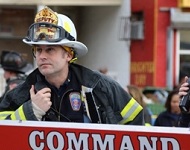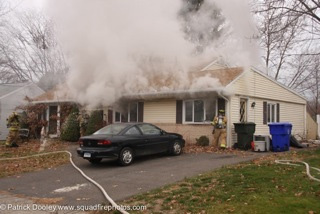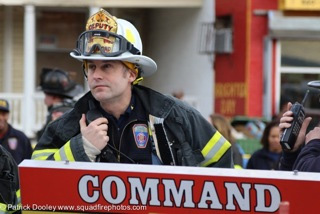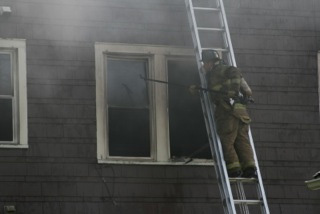

Photos by Patrick Dooley/www.squadfirephotos.com.
By G. Howard Blythe
As the mission of the fire service expands to be a more all-hazard emergency response service, the operators within the service are expected to successfully handle more complex situations. A goal that all departments, small and large, professional or volunteer, should strive for is “operational resilience.” This is the ability of an operating individual or unit to interpret and adjust to an ever-evolving and dynamic situation in a timely and effective manner while still operating toward a defined strategic/operational objective.
Although this concept may seem like a trait we already have and successfully execute, it is clear that when we look at our standard operating procedures (SOPs) and our training, we are not fostering the necessary skills or cultivating the proper environment for this type of discipline to take hold and blossom.
The locations and the types of incidents we handle are not within our sphere of control. However, we can control how we approach these incidents. Two of the core principles of operational resilience are a well-defined and understood operational objective and empowering the operators to make tactical decisions at the lowest level possible. This gives our organizations a holistic understanding of the entire operation and all the moving parts in it and allows our force to be as fast acting and fast reacting as possible. Given the nature of our operational environment, this type of approach allows for the most flexibility and gives us a great starting point for nearly all of the operations to which our departments will respond.
Operational resilience is an organization’s ability to efficiently handle very complex situations. How an organization sets out to achieve this starts at the very top of the department, and it needs to spread through every level of the organization, changing the way everyone approaches their role and duties within the department. This begins with a clear definition of the department’s strategic goals and operational objectives for all activities in which it is expected to participate. These goals and objectives also need to be clearly documented for all members to review and understand. Although the specific incidents to which the department will respond are unknown, the objectives of our operations at these incidents should be predetermined. In most cases, the end goal of an operation will not change or fluctuate during each incident. This mission-driven approach focuses the incident commander (IC) on the macro issues of the incident and allows the operating members to handle the micro issues.

With clear goals and objectives laid out, the operators are given tactical flexibility to achieve their assigned objectives. This system allows each member to make decisions on objective completion based on up-to-the-second situational knowledge. The result is a highly reactionary and flexible organization, with three compounding benefits, which follow:
- By allowing tactical decisions to be made at this level, the units with the most up-to-the-second information are reacting to what they see without delay, which decreases the chance of the incident escalating.
- With members reacting and adjusting quickly, we are saving time operationally, which, in the environment of limited air supply and exponentially growing fires, is a great operational payoff. This ability of operators to immediately adjust for conditions is reliant on them doing so while not compromising the overall operational objectives of the incident.
- By allowing members to adjust quickly, they can react to small changes in conditions. This prevents small issues from becoming big issues and keeps the tactical adjustments needed small in number and scope.
One of the two activities that the IC will have to closely monitor in this type of structure is communication. Communication is key when dealing with any type of fluid changing environment. When tactical adjustments have been made, operating units need to transmit the pertinent information regarding that change. This type of communication is made laterally to the other operating members or units directly affected while also being broadcast to all operating elements at the scene, keeping everyone with the most up-to-the-second picture of the operation. As information moves laterally through the operating organization, command should be making note of all conditions and tactical changes being made and ensuring that clear and concise communication is indeed happening. The IC then becomes a communication monitor and facilitator instead of a “choke point” for all information.
The second activity which command must closely monitor is the proper coordination of operational units. Operating units that hear the broadcasted information need to understand how the transmitted change or condition affects their portion of the operation. Adjusting accordingly to accommodate the specific condition and coordinating assigned activity with the changes made by the other operating units to compensate, is crucial. As conditions are being transmitted, members operating can identify possible operational gaps and fill them as they arise. The IC then is not consumed with managing smaller issues specifically or individually, but rather listening to ensure the proper members or units are responding appropriately and nothing is being overlooked. Thinking of the IC as being responsible for the facilitation of communication and coordination and ensuring resource availability and not as much playing the traditional role of command and control is that for which ICs should strive.
Within this structure of operation, failures and mistakes can and will happen. Our organizations need to redefine what we classify as an “operational failure” and what is a “mistake.” Failures need to be handled according to department protocols. Mistakes, however, need to be handled as opportunities for collective learning. Tactics that lose sight of our defined operational objectives and strategic goals are most definitely failures.
A second category, which is most certainly a failure, is inaction. If a member or unit fails to perform at all, this is a failure of inaction and it cannot be overlooked. When a unit or individual makes a choice that in hindsight could have been better, this is not a failure but a mistake that everyone can learn from and avoid in the future.
Choices and actions which turn out to not be the best option available need to be viewed as collective learning opportunities, and they need to be framed and addressed that way. An atmosphere of responsibility—free from judgment—needs to exist for this idea to gain traction and achieve the desired results. This organizational shift to “tolerance for mistakes” is, many times, one of the toughest challenges to overcome. But, as previously mentioned, the heads of the organization need to embrace the principles of this philosophy and set the cultural tone for the rest of the department. When an environment is as free of judgment as possible, this is when the freest exchange of information and collective learning from individual experiences occurs. This structure needs to be adopted by the organization’s chief executive and embraced by all the leaders and supervisors within the organization. This, in many cases, means changing our approach to operations and treating every run and operation as a learning opportunity.
Another way supervisors and leaders can help to implement this type of culture is by setting the example when it comes to sharing experience and encouraging collective learning from each operation and choice made. It is very important to be deliberate in selecting the term leader because the informal leaders within each organization are more influential than the formal leadership. It is imperative to have these individuals on board.

We strive for educated and trained individuals who are empowered to make decisions and initiate actions. This presumed expertise does not rest solely at the head of the organization or unit but rather experience is spread throughout the organization; collectively, the organization is better off allowing the individuals with expertise to make decisions relevant to that expertise. It then becomes the job of the IC to facilitate that action.
The incident command system is a highly adaptive and flexible system under which to operate. When an organization insists on a centralized mission control model which requires constant approval for action, the tempo of the entire operation begins to slow and can create an operational environment full of drones who, lacking orders, take no actions. Operationally resilient organizations practice a system of decentralized mission objectives, which are clearly understood and need not be defined by an IC or supervisor once operations have begun. The IC can then focus on progress toward the overall operational objective and insure that all parts of the organization are self-actuating, communicating, and coordinating with each other properly. While doing this, the IC is also monitoring the overall conditions and determining if additional resources will be needed. It is the IC’s responsibility to ensure that those resources are available if needed. If conditions dictate IC involvement in adjusting operational activities, this is, by all means, allowed and encouraged when it comes to situations that have deteriorated beyond acceptable operational limits. This type of action should not, however, be the norm, and when the IC starts giving these types of orders, it should be a signal to all operating personnel that something is not going well and operations may need to change drastically.
Training members to operate effectively within this structure is heavily dependent on members embracing two principles. First, all members need to fully understand their department’s operational objectives and what responsibilities they have in filling their portion of the operation. Second, members need to understand and be trained for the high level of individual performance and decision making required to function effectively. Once these principles are embraced, members need to understand the level of communication needed for operational success. Many of these communications are made laterally within the organization, informing directly affected members of conditions or situational changes. “Broadcast transmissions” can be integrated into the operation for the general knowledge of the IC and other operating units. Operators can exercise flexibility of tactics, but never outside the scope of operational objectives. Multiple operators may be charged with overlapping objectives, which they need to be coordinated with each other. These are some of the crucial communications for which the IC should be listening.
Training members to have a highly developed sense of situational awareness is what will help them to make informed, operationally effective decisions. Through honest critiques of actual operations and training sessions, members can begin to gather the knowledge needed for recognition-primed decision making; this is the ability to make decisions based on previous experiences with similar type situations. Critiquing actual operations immediately postincident is effective because of how recent in the past the decisions were made. The environment in which we operate is nearly impossible to recreate, so real-world operations offer a more realistic setting for learning to take place by using timely critiques. Training as a group is crucial to the collective learning aspect of this structure. The collective approach to learning and critique is what will help all operating members know what changes work best and what effect they will have on the rest of the operation.
From an administration perspective, this type of operational framework meshes best with the new public service type of administration. The traditional model of public administration, which depends heavily on a rigid hierarchal structure, is a slow system. It does not account for individuals in lower levels of an organization empowered to act. It also favors a system of finding the “one best way” to accomplish goals and objectives. As anyone who has spent time in the fire service knows, operationally, we need more flexibility than that because there is not just one way for us to execute any task. Wanting our administration to reflect our operational structure, it is obvious that blind adherence to the traditional model of public administration is not the best fit for this structure, although it does have some positive attributes that can be used.
The new public management structure is also lacking because of its outcome-based system of performance measures. In new public management, much of the focus is put on quantifying results for evaluation and measure for overall effectiveness. The basic principle of applying measures established in profit-driven organizations and applying them to nonprofit organizations is a dangerous and tricky business. Many times, this leads to organizations focusing on measures, which people can easily understand, but at the expense of rational decisions, which our experience tells us is the better choice. Framing the public as “customers” instead of just the “public” that we are duty bound to serve is a mistake for any emergency service. New public management is not an ideal administrative system to use, but it also does have some features, which are applicable and can be used.
The best administrative model to follow for this type of operational structure is the new public service model of administration. This model embraces some of the best features of previous administrative models and offers a more flexible interactive form of management. This style of management lends itself well to the principles of operational resilience because all members of the organization are viewed as vital and capable of making significant decisions and contributions.
To first implement this structure of operation, an organizational commitment to this philosophy needs to be embraced. The first step is the training of officers to practice the forms of collective learning and engage the members under their command in this collective group environment as much as possible. In some cases, this is in formal training environments; other times, it is informal impromptu discussions and demonstrations that encourage sharing of ideas at all times. The education and empowerment of members is our end goal.
The one trait which needs to be instilled in all of our members is discipline. This is one of the most underused words and principles in our industry. Discipline is what keeps us operationally ready at all times. This is the trait that will help us build the muscle memory needed to execute necessary tasks in a highly effective and efficient manner. Discipline integrates goals, objectives, situational awareness, tactical needs, and acceptable risk into the ability to react and perform in an operationally meaningful way. The value of discipline on the fireground cannot be overstated or overemphasized.
This form of operational structure is the polar opposite of a micromanagement-based style of operations. All of the negative byproducts of micromanagement, which are well documented, are eliminated in this structure, which is based on trust, discipline, and empowerment. Its success is derived from honest self-evaluation and collective learning. One of the biggest adjustments in practices departments must make is the manner in which it self-critiques. As an industry, we are not good at honest self-evaluation. The fire service, many times, does not differentiate between an operation which was properly executed and an operation which ended successfully by chance. We must analyze what we do and determine if we just “failed forward” or if we succeeded. There is a difference. We need to work on not reinforcing bad habits just because everything turned out okay but to determine what we did right and what we can do better.
This operational structure can continually be refined and expanded to include all operations in which emergency services provide. As new members are introduced, the group has a chance to remember old lessons, and the new members can learn from the experience of the senior members. The limits of this structure have yet to be fully realized. As we see more administrative commitment and more embracing of the collective learning and shared experience aspect of the structure by first- and second-line supervisors, the benefits will keep expanding and growing.
The most successful organizations I have ever seen or of which I have been a part embrace this type of structure and allow it to elevate their members’ commitment and the organization’s operational tempo. Collective success is the only way to succeed organizationally. We owe it to municipal administrators, stakeholders, and citizens to provide the best service possible.
G. HOWARD BLYTHE is a 14-year veteran of the Fire Department of New York, where he is a firefighter assigned to Ladder Company 27 in the Bronx. Previously, he was assigned to Ladder Company 15 and Ladder Company 113. A graduate of John Jay College in New York City and Oklahoma State University in Stillwater, he has a BA degree and an MS degree. He is a nationally certified fire instructor III and fire officer IV. He is an adjunct instructor for the Connecticut Fire Academy.

